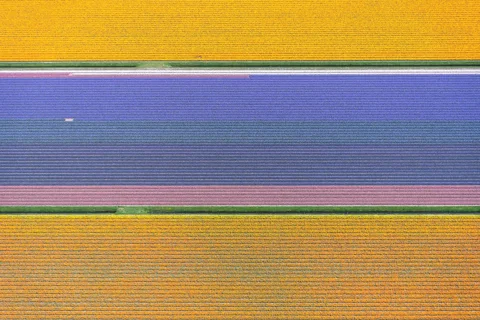In order for all the pension funds it works for to responsibly transition to the renewed system, new pension schemes and processes need to be developed within APG, as well as a single IT system in which all the schemes are administered. Wim Koeleman, director of the Pension of the Future program, is responsible for ensuring that all these preparations for the renewed system are on the right track at APG. “After all, we do have to deal with hard, legal deadlines that don’t allow for much leeway.”
The publication of the annual report - themed “A new reality” - is a good time to stick the dipstick into the organization and ask Wim to explain APG’s preparation for that reality. The first major challenge in this is to ensure that APG’s IT systems and processes are ready in time to responsibly carry out the transition to the renewed system, says Wim.
How are you ensuring that those systems and processes will be ready on time?
“We do that by constantly testing: first an individual software component, then a number of components, then an entire process, and finally you test the entire chain that contains that process. Those tests are done based on our client journeys, for example, “Retiring”. We then test all the steps for that from start to finish. In the course of the year, we do a number of such tests, until both we and the funds - in this case PPF APG and PWRI - have determined that the new systems and processes are reliable and that we can go into production with them.”
What else has priority in 2024?
“We should also be able to answer in the affirmative to the question: are we ready to convert all pension entitlements - accrued under the old system - and pension benefits to the renewed pension scheme, i.e. convert them into personal pension assets? As it looks now, we will do three trial migrations for that in 2024, the first of which is now behind us. In addition to this conversion of pension entitlements to personal pension assets, we have to take all the data in the existing systems and pump it into the new system, which has a slightly different layout, different fields and different definitions.”
I would imagine that communication with participants is also starting to play an important role this year. What’s happening on that front?
“Adequately informing the participants of the pension funds we work for is indeed another major challenge. As it looks now, sometime in September they will receive their regular Uniform Pension Overview - UPO - showing how many entitlements a participant has accrued as of January 1, 2024 under the existing pension system. This time, we are adding a transition statement, in which the individual participant can see for the first time how much that would be in the renewed system. And that’s a challenge in that the rules for that are not yet fully crystallized.”
Preparing for the transition puts a strain on some employees. In addition, employees must be trained for the new pension schemes and work methods. At the same time, there needs to be sufficient capacity for day-to-day work. How do you deal with that area of tension?
“By taking our clients’ transitions in three steps, spread over three years. We’re starting with PPF APG and PWRI, which are transitioning to the renewed system in early 2025. Of the thousand people working in pension administration, about thirty are working on these funds, and we have provided some extra capacity there. In the last period before we go into production, the construction team working from within the Pension of the Future program will also physically be on the same floor as pension administration. That way they can help each other, ask each other questions and see how it all works. In that first year, we’ll try to learn as much as we can. We’ll take those lessons with us when bigger funds switch over in the following year: bpfBOUW, SPW and BPF Schoonmaak. We will learn from those, too, and only in the third year will we then switch ABP, which a lot of teams work for. We won’t start with a big bang in 2025, we’ll start with a small bang and build it up gradually.”
Meanwhile, you are also already preparing the funds that will transition to the renewed system in 2026 and 2027. Does this not increase the pressure on the organization?
“Well, it does and it doesn’t. You have to look carefully at exactly who in the organization has to work for those funds. There are different schedules and we have different processes to go through. It starts with a process of designing new pension schemes. This involves advisors from our ALM department, Actuarial Department and lawyers. They help social partners and pension fund boards to set up those schemes in detail. So, at that point the work lies with them. Then people have to get to work designing new processes and systems. Actually, we’ve been working on that for two years, because we started building a generic system based on assumptions that would be applicable to every fund. Then you make fund-specific adjustments. Each time, you have to see who has to work on something, whether that creates a peak load or whether you can spread this work out over time. So far, we have been able to spread it out quite reasonably, but the tension is building up. Especially with certain people with specific knowledge, overview and experience, who are needed every time. In the end, we are working on a lot of changes at the same time. Not only are we changing our processes and systems, we are also adapting the pension schemes themselves, changing our services and the way we communicate. And all these different parts also have to interact in the right way.”
How do you ensure that employees keep their cool under this mounting pressure, beyond proper work scheduling?
“It is very important to have regular physical meetings with everyone involved in the Pension of the Future program. So, every few months we have a joint meeting that is now being attended by a few hundred people. After a joint kickoff, we break up into small groups, each with their own sub-topics. At meetings like this, I always make the call for everyone to look out for each other. Ask how people are doing, see if you can help each other. Because you don’t always see it when the pressure gets too intense for someone, especially if you’re working hybrid. I also ask employees to work together in the office on fixed days, as much as possible. We have quite a bit of management on this program and progress meetings, in which we continuously assess whether we are on track, whether we need to make adjustments and what risks we are seeing. There is a lot of focus on that. But ultimately, we do have to deal with hard, legal deadlines that don’t have much leeway, and hard schedules. This can be well organized, but sometimes things can’t be done the way they should be done and just have to be done the way they can be done.”



